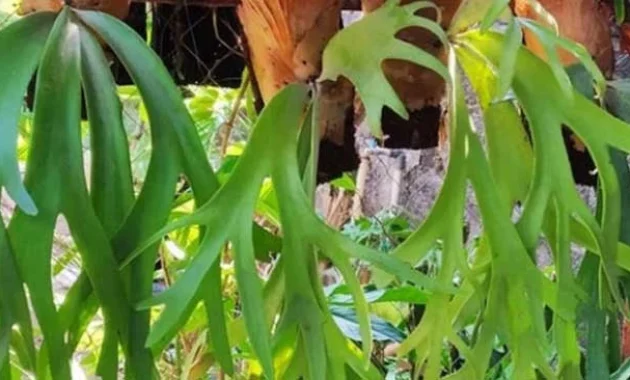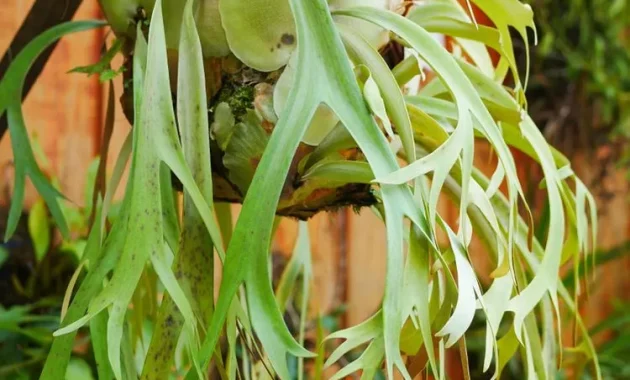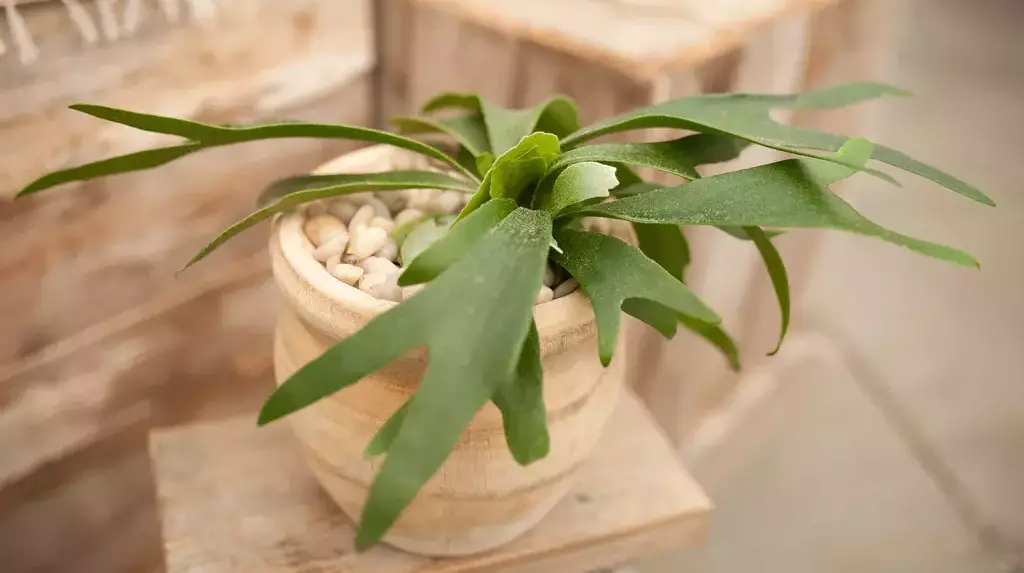Staghorn ferns, known for their exotic and striking appearance, are popular houseplants that require specific care to thrive. However, overwatering can be detrimental to their health, leading to root rot and other issues. This article aims to provide a comprehensive guide on how to identify signs of overwatering in staghorn ferns and offer effective solutions to save these cherished plants.
The signs of overwatering in staghorn ferns are crucial to recognize. They include yellowing fronds, wilting leaves, and a foul odor emanating from the potting medium. Understanding these symptoms is essential in preventing further damage and ensuring the plant’s survival.
This article will also delve into the step-by-step process of saving an overwatered staghorn fern, including adjusting the watering schedule and implementing proper drainage techniques.
Moreover, this article will touch upon the signs of underwatering in staghorn ferns, as it is equally important to maintain the right balance of moisture. Additionally, valuable tips on watering staghorn ferns will be provided to readers, offering insights into the optimal watering frequency and techniques.
By following the expert advice and guidelines outlined in this article, readers will acquire the knowledge needed to rescue their overwatered staghorn ferns and foster their growth and well-being.
Key Takeaways
- Signs of overwatering in staghorn ferns include yellowing fronds, wilting leaves, and a foul odor.
- Proper drainage and adjusting the watering schedule can help save overwatered staghorn ferns.
- Pruning damaged fronds and roots is important in saving an overwatered staghorn fern.
- Treating root rot with a fungicide and repotting into well-draining soil are necessary steps in the revival process.
Signs of Overwatering in Staghorn Ferns
Overwatering in Staghorn Ferns can lead to several visible signs of damage.
One of these signs is the yellowing and browning of the leaves, indicating that the plant is not able to properly absorb water.
Another sign is the basal fronds turning black, which is a clear indication of overwatering.
Additionally, the appearance of black spots on the fronds is another symptom of overwatering, as it can indicate fungal or bacterial infections.
Root rot is also a common issue caused by overwatering, leading to the softening of the leaves and overall decline in plant health.

Yellowing and browning of the leaves
Excessive watering of the staghorn fern leads to a distressing sight as the once vibrant leaves gradually lose their green hue, turning first yellow and then eventually brown. This leaf discoloration is a direct result of excessive moisture in the soil and the subsequent damage it causes to the fern’s chlorophyll.
Overwatering creates an environment that promotes fungal growth, further compromising the health of the plant. As the soil becomes waterlogged, it fails to provide proper drainage, causing the roots to absorb the excess moisture. This leads to wilting leaves and a lack of vital nutrients for the fern.
To prevent yellowing and browning of the leaves, it is crucial to ensure proper drainage and avoid overwatering.
Basal fronds turning black
The discoloration of the basal fronds, specifically turning black, can be observed as a direct consequence of an unfavorable water balance in the staghorn fern, indicating the need for appropriate moisture management.
When the plant is overwatered, the antler fronds, which act as an anchor for the basal fronds, are unable to bear the excessive moisture, resulting in blackening or browning at the bottom. This blackening is often a sign of fungal infection caused by the prolonged presence of moisture on the fronds.
To address this issue and prevent further damage, it is crucial to implement proper drainage for the staghorn fern. This can be achieved by using well-draining soil and ensuring that excess water can freely flow out of the pot.
Additionally, disease prevention measures such as avoiding overwatering and providing adequate air circulation can help maintain the health of the plant.
Appearance of black spots
The presence of black spots on the fronds of the fern indicates a fungal infection, which can compromise the overall health and vitality of the plant. These black spots are caused by the growth of Rhizoctonia fungi, which thrive in moist environments such as overwatered soil. Prevention measures play a crucial role in addressing this issue.
Firstly, it is important to ensure proper drainage by using a well-draining potting mix and avoiding waterlogged conditions.
Secondly, maintaining a balanced nutrient supply is essential to promote the plant’s resistance against fungal infections. Adequate levels of nutrients, particularly nitrogen and potassium, can enhance the fern’s immune system.
Additionally, maintaining the appropriate humidity levels can help prevent fungal growth. Regularly misting the fronds can create a humid environment that discourages fungus from taking hold.

By implementing these prevention measures, the occurrence of black spots on the fronds can be minimized, ensuring the health and vigor of the staghorn fern.
Root rot
Root rot in the staghorn fern is a result of inadequate drainage and improper soil composition, leading to detrimental consequences for the plant’s overall health and vitality.
To prevent root rot in staghorn ferns, it is crucial to understand their specific water requirements. These ferns prefer moist but not waterlogged soil. Proper drainage techniques, such as using well-draining soil and pots with drainage holes, can help prevent excessive water retention.
Identifying early signs of root rot is essential for timely intervention. Look out for a foul odor emanating from the roots, as well as patches of brown and black spots on the fern leaves.
If root rot is detected, treating it effectively is crucial. Remove the affected parts of the fern, trim the roots, and repot in fresh, well-draining soil.
Additionally, adjusting watering practices and avoiding over-fertilization can help prevent future occurrences of root rot in staghorn ferns.
Softening leaves
Softening leaves in staghorn ferns can be attributed to excessive moisture absorption, leading to cell damage and nutrient deficiency. When ferns are overwatered, the root and stem absorb more water, which eventually reaches the leaves. As a result, the leaves accumulate an excessive amount of water, causing damage to the leaf cells.
This process, known as leaf edema, causes the leaves to lose their firmness and develop a mushy texture. The softening of the leaves is also a result of root rot, which occurs when the roots become rotten and are unable to absorb nutrients for the fern’s growth. Consequently, the leaves not only soften but also turn yellow due to the lack of essential nutrients.
This condition is further exacerbated by wilting fronds, drooping foliage, and limp stems, all indicative of waterlogged soil.
Damaged core of the fern
Excessive moisture absorption resulting from overwatering can lead to the drying and subsequent damage of the core of the staghorn fern, as indicated by the presence of black or brown patches on the stems and core, accompanied by a foul odor. To prevent further damage and save the overwatered staghorn fern, it is crucial to take immediate action.
Here are some tips to help restore the fern’s health:
- Regrowth Process
- Remove the damaged fronds and stems to encourage new growth.
- Provide proper lighting and temperature conditions to support regrowth.
- Maintain a consistent watering schedule to prevent further stress on the fern.
- Preventing Overwatering
- Ensure the pot has proper drainage to prevent waterlogging.
- Allow the top layer of soil to dry out before watering again.
- Adjust watering frequency based on the environmental conditions and the fern’s needs.
- Fertilizing Tips
- Apply a balanced liquid fertilizer during the growing season.
- Follow the recommended dosage and frequency for optimal nutrition.
By following these staghorn fern care guidelines, you can help the damaged core recover and ensure the fern’s overall well-being.
How to save an overwatered Staghorn Fern
When attempting to save an overwatered Staghorn Fern, it is important to begin by pruning any damaged fronds or roots. This will help to remove any areas of decay and promote new growth.
Additionally, allowing the plant and soil to dry out is crucial in preventing further damage and encouraging root health. Treating any root rot that may be present with a fungicide can also aid in the recovery process.
Repotting the fern into well-draining soil and adjusting the watering schedule to prevent future overwatering are further steps that can be taken to ensure the plant’s revival.
Prune the damages
To minimize the impact of overwatering, the damaged parts of the staghorn fern, such as the root, stem, and shield fronds, must be carefully pruned using sterilized tools to prevent contamination. Pruning techniques play a crucial role in saving an overwatered staghorn fern.
Firstly, inspect the damaged root and fronds, and with a sharp pruner, carefully remove the rotten root.
Secondly, remove the plant from its pot and soil, cutting off any black, yellow, or brown leaves. This step ensures the removal of diseased parts and protects the healthy leaves and fern stem. Additionally, wiping off any fungus from the plant is essential to prevent contamination.
After pruning, it is important to consider preventing overwatering by adopting alternative watering methods and allowing the soil to dry out between watering sessions. Reviving damaged leaves can be achieved by providing adequate sunlight and humidity.
Finally, fertilizing the fern after pruning will help it regain its strength and vitality.
Dry the plant and soil
Drying the plant and soil is an essential step in mitigating the effects of overwatering and restoring the health of the plant.
When a staghorn fern shows signs of overwatering, such as yellowing fronds and root rot, it is crucial to address the issue promptly.
To rehydrate the plant and prevent further damage, it is necessary to dry out the soil thoroughly. This can be achieved by removing the plant from its current spot and using newspapers or kitchen towels to absorb excess moisture from the soil.
Additionally, increasing the amount of light and temperature the plant receives can expedite the drying process. Using a hairdryer on a cool setting can also aid in drying the soil without harming the rootball.
Once the plant and soil are dry, it is important to replace the soil, ensuring it is dry as well, and then return the plant to its pot.
Following these steps and adjusting watering habits to meet the plant’s water requirements can help prevent future overwatering and root rot.
Treat root rot
Treatment of root rot involves careful inspection of the plant’s roots to identify any signs of decay or rot. Root rot can be caused by overwatering, poor drainage, or the use of contaminated soil. When inspecting the roots, it is important to look for brown or black mushy areas, foul odor, or slimy texture, as these are indications of rot.
To treat root rot, it is necessary to remove the affected roots by using clean garden scissors to cut above the brown or decayed part. It is crucial to avoid damaging the healthy roots during this process. Afterward, the plant should be transferred to a new pot with a well-drained, porous potting mix to prevent future root rot.
To prevent root rot, it is important to ensure proper watering practices, provide adequate drainage, and avoid using contaminated soil. Regularly inspecting the roots for signs of decay and providing proper care can help maintain healthy roots and prevent the occurrence of root rot.
Repot the plant
After treating root rot in an overwatered staghorn fern, the next step is to repot the plant. Repotting is essential to provide a healthier environment for the fern’s roots and prevent further waterlogging.
When repotting, it is crucial to choose the right pot and soil mixture. Opt for a pot that is slightly larger than the previous one, allowing room for the fern to grow. A good potting medium for staghorn ferns should be porous and well-draining, such as shredded pine bark or sphagnum peat moss. This will ensure proper air circulation and prevent water from accumulating around the roots.
Additionally, repotting frequency should be considered. It is generally recommended to repot staghorn ferns every 1-2 years to refresh the soil and stimulate growth. Proper drainage is also important to avoid waterlogging; thus, the pot should have drainage holes to allow excess water to escape.
By following these repotting tips, one can provide an ideal growing environment for an overwatered staghorn fern.
Adjust watering schedule
To optimize the well-being of a staghorn fern, it is crucial to carefully adjust the frequency of its irrigation, ensuring that the base of the plant dries out adequately between waterings. Proper watering technique is essential to prevent overwatering and avoid waterlogged soil. Staghorn ferns require regular irrigation, but it is important to allow the top third of the pot to dry out completely before re-watering. Adjusting the watering schedule is key to maintaining the plant’s health. During the growing season, which is typically once every week, the plant should be watered. However, it is recommended to wait until the plant begins to wilt before re-watering. This allows the base of the plant to dry out, preventing waterlogged soil. By adjusting the watering frequency, staghorn ferns can thrive and avoid the negative effects of overwatering.
| Watering Frequency | Signs of Overwatering | Solutions |
|---|---|---|
| Too frequent | Yellowing fronds | Reduce watering frequency and allow the base to dry out between waterings |
| Too infrequent | Wilting fronds | Increase watering frequency and ensure the base does not dry out completely |
| Proper | Healthy appearance | Maintain the watering schedule and ensure the base dries out between waterings |
Signs of Underwatering in Staghorn Ferns
Wilting leaves and brown spots at the tips of fronds are visible indications of underwatering in staghorn ferns. A drooping plant and crispy foliage further suggest the lack of adequate water supply. To prevent underwatering, proper staghorn fern care is necessary, which includes maintaining a suitable watering frequency.
Signs of dehydration, such as brown spots and wilting leaves, can be mitigated by increasing the frequency of watering and misting. Staghorn ferns absorb water through their fronds, so misting and providing a more humid environment can also help maintain moisture levels.
It is important to note that underwatering can cause significant damage to the plant, resulting in little to no new growth and drying basal fronds. Therefore, it is essential to closely monitor and adjust the watering schedule to ensure the health and vitality of the staghorn fern.
Tips Watering Staghorn Ferns
Watering staghorn ferns correctly is essential for maintaining their health and vitality. To ensure proper hydration, it is important to follow these watering tips:
- Watering frequency: Water once per week in dry, hot times of year, and once every one to two weeks during cooler months.
- Moisture control: Allow the base to dry out in between waterings to prevent overwatering.
- Drainage solutions: Soak the root ball in water for 10-20 minutes or until the roots are fully saturated. Ensure excellent drainage to prevent waterlogging.
- Watering techniques: Water can be provided directly to the sphagnum moss slowly with a long narrow-tipped watering can.
By following these guidelines, you can prevent overwatering and keep your staghorn fern healthy.
Proper hydration, along with providing warm temperatures and misting, will help your fern thrive. Remember to check for signs like drooping fronds and dry soil to determine when it’s time to water.
FAQ’s about Overwatered Staghorn Fern
Can I use a moisture meter to determine if my Staghorn fern is overwatered?
Using a moisture meter can help determine if a staghorn fern is overwatered. Signs of overwatering include yellowing fronds and root rot. Prevent overwatering by allowing the soil to dry between waterings. In winter, reduce watering frequency. Repot if necessary.
How often should I water my Staghorn fern to prevent overwatering?
To prevent overwatering, proper watering techniques for staghorn ferns involve allowing the top inch of the soil to dry out before watering again. Signs of underwatering include brown, wilted fronds. The best soil mix for staghorn ferns is a combination of peat moss, perlite, and orchid bark. To revive a dehydrated staghorn fern, soak the entire plant in water for 1-2 hours. Watering frequency for staghorn ferns varies depending on the climate, with more frequent watering required in hotter climates.
Can I save an overwatered staghorn fern by simply reducing the amount of water it receives?
Reducing the amount of water alone may not be sufficient to save an overwatered staghorn fern. Alternative solutions for overwatered staghorn fern recovery include changing to fast-draining soil, pruning dead and diseased roots and fronds, and treating roots with a fungicide.
How long does it take for a staghorn fern to recover from overwatering?
The recovery time for an overwatered staghorn fern depends on the severity of the damage and the steps taken to remedy the situation. Alternative solutions include adjusting watering frequency, improving drainage, and using fungicides to prevent rot disease.
Can I use any fungicide to treat the roots of an overwatered staghorn fern, or are there specific ones I should use?
Different types of fungicides can be used to treat the roots of an overwatered Staghorn Fern. It is recommended to use a fungicide that contains hydrogen peroxide, as well as natural antifungals such as cinnamon, activated charcoal, and chamomile.
Is it possible to mount a young staghorn fern that has been overwatered, or is it better to wait until it matures?
Mounting options for a young, overwatered staghorn fern can be limited due to its vulnerability. It is generally recommended to wait until the fern matures before mounting it, as signs of maturity include a developed shield frond and root system.
How do I know if the potting medium I am using for my staghorn fern is well-draining enough?
Signs of improper drainage in a potting medium for a staghorn fern include waterlogged soil, stagnant water, and slow drying. To ensure proper drainage, use a well-draining potting medium with shredded pine bark or sphagnum peat moss.
Are there any specific signs of overwatering in Staghorn ferns during the winter months?
Signs of overwatering in staghorn ferns during winter include yellowing or wilting leaves, root rot, and excessive moisture in the soil. To prevent overwatering, adjust the watering schedule and consider repotting the fern in a well-draining medium.
Can I save an overwatered Staghorn fern by repotting it in fresh soil?
Repotting an overwatered staghorn fern in fresh soil can be beneficial as it allows for better drainage. However, alternative solutions such as drying out methods and adjusting watering habits should also be considered. Signs of overwatering include yellowing fronds and root rot. To prevent future overwatering, ensure proper drainage and allow the soil to dry out between waterings.
Conclusion
Staghorn ferns are beautiful and unique plants that require careful attention when it comes to watering. Overwatering can be detrimental to their health, causing root rot and other issues. Signs of overwatering include yellowing leaves, soggy soil, and a foul odor.
To save an overwatered Staghorn fern, it is important to remove it from its pot, trim away any rotting roots, and allow it to dry out before repotting.
Underwatering, on the other hand, can result in dry and wilting fronds. Proper watering techniques involve soaking the plant thoroughly and allowing it to dry out between waterings.
With these tips, you can ensure the health and longevity of your Staghorn fern.













Comments are closed.